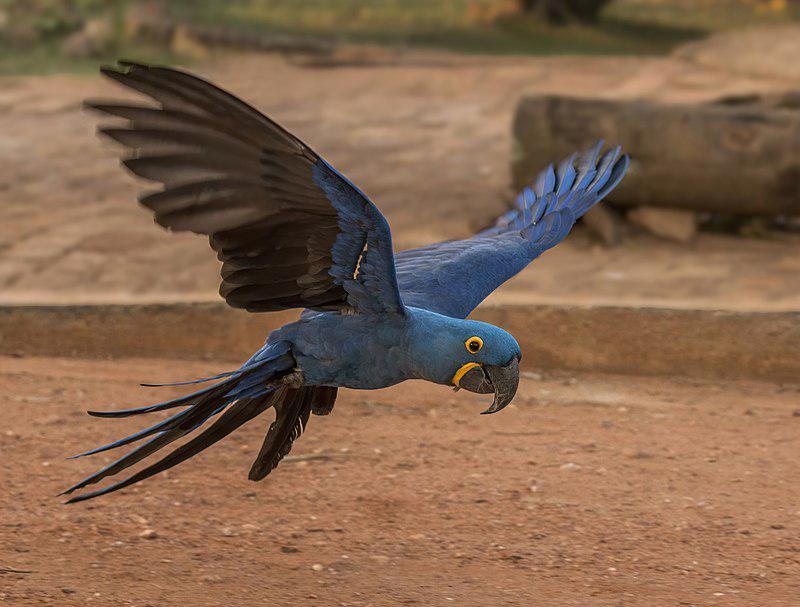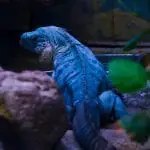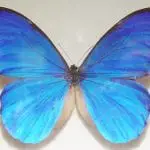The hyacinth macaw, widely known as “the king of parrots,” is native to central and eastern South America. Its scientific name is Anodorhynchus hyacinthinus. It is the largest macaw and also the largest flying parrot species. Owing to a stunning appearance and big personalities, the hyacinth macaws are among the most expensive of birds kept as pets. This bird is playful, inquisitive, and able to mimic human sounds quite well.
Appearance
· The hyacinth macaw is approximately a meter long from the top of its head to the tip of its tail. This makes it the longest species of parrot. It weighs around 1.5 kg.
· The bird has a cobalt blue color. It is often simply called the “blue macaw”.
· There is a vibrant yellow ring around the eyes. There is also a yellow area underneath the beak.
· Each wing is close to half a meter long. The large wings help it to reach flight speeds of up to 55 kph. It has a very long and pointed tail, and a strongly hooked beak. Its beak lacks the ridges characteristic of other macaw species.
· It has a black tongue with a yellow stripe running down its side.
· The hyacinth macaw has zygodactylous feet. This means that it has two toes that point forward and two that point backward.
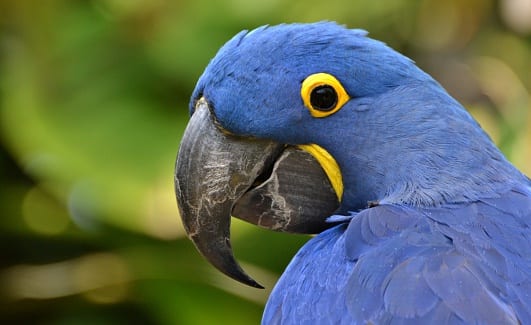
Habitat
The blue macaw is indigenous to Brazil, Bolivia, and Paraguay. It lives in the scrublands at the outskirts of the Amazonian rainforest. It may also be found in grasslands and lightly forested regions.
Feeding
· In the wild, the blue parrots harvest nuts from the acuri and bocaiuva palm trees and feed on them after breaking the nuts with their powerful beaks.
· They forage in areas with a lot of cattle and extract digested nuts from the dung of cattle.
· They also feed on fruit and green vegetation in the wild.
· Pet hyacinths can be fed on fruit, vegetables, leafy greens, and plenty of nuts. They require more carbohydrates than most other parrot species as they metabolize very quickly.
Personality and Behavior
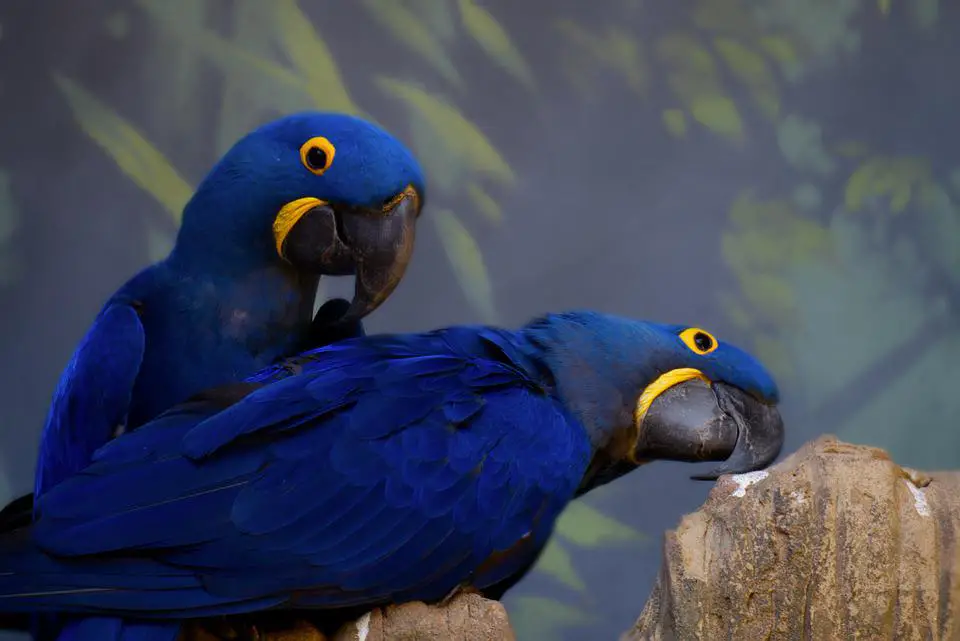
· The blue hyacinth is a social bird. In the wild, they frequently travel together in flocks of 1-8 pairs. Macaw pairs remain bonded to each other.
· Blue parrots have a wide range of vocalizations. These include deep growls, loud screeching, and high trills. They are capable of purring too. In large flocks, they tend to make the most noise.
· It is often called a “gentle giant” due to its affectionate and playful nature.
· When it is kept as a pet, it needs a lot of time to play with other parrots or humans. They can be easily trained with positive reinforcement and bond strongly with their human caregivers. They need a lot of spacious area to live in. If confined, they may show neurotic behavior. In such situations, they produce loud vocalizations and may inflict self-harm. When disturbed, they fly overhead in circles and screech furiously.
· Hyacinth macaws play rough with their human keepers and other hyacinths. Their beaks are powerful and can exert about 200 pounds (ca. 91 kg) of pressure on every square inch. As a part of their play, they habitually nip all kinds of hard surfaces. They can be destructive if they are not provided with wooden toys and branches to chew on.
· Hyacinth macaws can memorize a good number of words and phrases. These intelligent creatures can sometimes contextualize the use of some of these words and phrases.
Breeding
· The blue macaws have low annual reproductive rates: only about 7-25 offspring may be produced every year from 100 pairs of adult macaws. However, this is counteracted by their long lifespans, which may in some cases be longer than 60 years.
· They have a monogamous mating system and generally remain with one partner for their entire life.
· Most nesting takes place in the wet season. Hyacinth macaws nest in tree hollows up to 14 meters off the ground. They lay 1-2 eggs per clutch which are incubated for 25-28 days. The female spends most of her time with the eggs during this period and the male feeds her.
· Jays, crows, toucans and skunks are common blue macaw egg predators. The adults usually manage to protect most of their eggs. As a result the hatching rate is about 90 percent.
· Chicks fledge in about 13 weeks. They stay with the mother for another 18 months, after which they attain independence. They reach sexual maturity in 5-10 years. Females attain sexual maturity before males.
· For reasons that are not clear, hyacinth macaws fail to reproduce successfully in captivity. Even when they lay eggs, most of the embryos die.
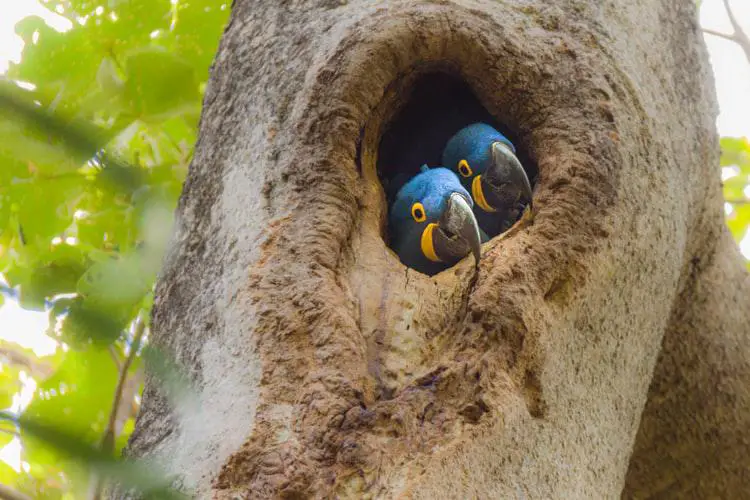
Today the blue macaw is an endangered species. The species has been labeled as ‘vulnerable’ on the IUCN Red List because of the rapid reductions in their numbers. There are only an estimated 2500 -5000 of them left in the wild. Unfortunately, they live in an area of South America that is undergoing rapid urbanization. Cattle ranchers often burn large spans of forest home to these birds, to make space for their rearing activities. Widespread deforestation has resulted in the loss of much of their habitat. It has been locally hunted by tribal people for food and to use its feathers for headdresses and ornaments. Hunting and trapping by humans for pet trade has also contributed to the reduction in their numbers.
The blue macaw is protected by law in Brazil and Bolivia. International trade is illegal as it has been listed on Appendix 1 of the CITES. Several studies and conservation initiatives have been undertaken. The conservation measures include the employment of artificial nests and chick management techniques. Raising awareness among cattle ranchers helps reduce habitat loss. Notably higher populations of blue macaws are held captive today in zoos and private collections, where they find a niche to live and breed.
The numbers of hyacinth macaws are expected to not decrease further with the widespread application of conservation measures. It would nevertheless take consistent and concerted efforts to prevent this species from being lost to us in time.

